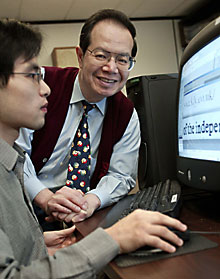Improving computer fonts may help prevent eyestrain
Ching Y. Suen saw increasing myopia in Asian children

Professor Ching Y. Suen is studying which fonts produce the least amount of eyestrain. His research will identify problem fonts, and could lead to designing fonts that are easier on the eyes.
Photo by Andrew Dobrowolskj
Anyone who spends a lot of time reading has occasionally had to squint to decipher badly printed documents or fuzzy fonts on computer screens. In the future, such eyestraining experiences may become less common, thanks to Concordia computer science professor Ching Y. Suen.
Suen is interested in the legibility of various print fonts. “We are now investigating which fonts are easier to read by computers, since that is easier to study, and then we will compare statistics on recognition by humans,” he said in an interview.
“The long-term goal is to identify print fonts or invent some new ones that will soothe our eyes and prevent decline due to too much reading.”
He has already determined that some fonts are more legible than others because certain letters – l-I, c-C, and a-s, for example — are easily confused, and that typesetting characteristics, such as the spaces between letters, also make a difference.
Suen is director of CENPARMI, Concordia’s Centre for Pattern Recognition and Machine Intelligence, a multidisciplinary research centre established in 1988.
“The field of pattern recognition involves methods of enabling computers to recognize anything that is produced by humans: handwriting, voice, iris, objects,” he explained.
“Our research has mainly touched on the recognition of handwriting and of material printed in different fonts, but we’ve also done some research on fingerprint, palm, iris and face recognition.”
He continued, “We have been working on font recognition off and on for at least 20 years, but it has been more off than on. Now we are picking it up again because we have developed new software for recognizing multiple fonts.”
This software analyzes the shapes of the letters to identify them and analyzes words to see whether they are valid. For the past three years, CENPARMI researchers have been developing this software, and evaluating other commercial software, under a contract with Fujitsu Laboratories, the giant Japanese manufacturer of computer, telecommunications and electronics equipment.
What convinced Suen to refocus on font recognition was his concern about the increasing incidence of myopia (so-called shortsightedness) in children, especially in Asian countries. The incidence of myopia among children aged 12 to 17 is 64 per cent in Hong Kong, 44 to 66 per cent in Japan, and 24 per cent in the United States.
While several factors contribute to myopia, Suen notes that children in Asian countries have to read a great deal, and suspects that eye strain may be part of the problem.
Hundreds of type fonts have been invented over the centuries, although some, such as Times Roman, Helvetica, Letter Gothic, and Courier, are more widely used than others.
Suen wants to find out which fonts are better for our eyes. So far, his research indicates that upper case letters are more correctly recognized than lower case letters, italics are read less accurately than normal print fonts, and touching characters reduce the accurary of recognition.
He is funding the initial phases of this study with ongoing research grants, as well as some of the money he received as Research Chair in Artificial Intelligence and Pattern Recognition, a position established in 2001. “Once we produce some results, we hope to attract more funding,” he said.
Research is not Suen’s only contribution to his field. In the 31 years that Suen has taught at Concordia, he has supervised some 40 master’s and 20 doctoral students, and hosted 65 visiting scientists from all over the world. Most of his former students are now teaching at universities themselves.
Another contribution that gave him great personal satisfaction was an international conference on pattern recognition he chaired in Quebec City last year. His lieutenant organizers gave him a plaque in recognition of his leadership efforts that now holds a place of honour in his office.